What is Low Code Insurance Workflow Software?
Date
Jul 29, 25
Reading Time
11 Minutes
Category
Low-Code/No-Code Development
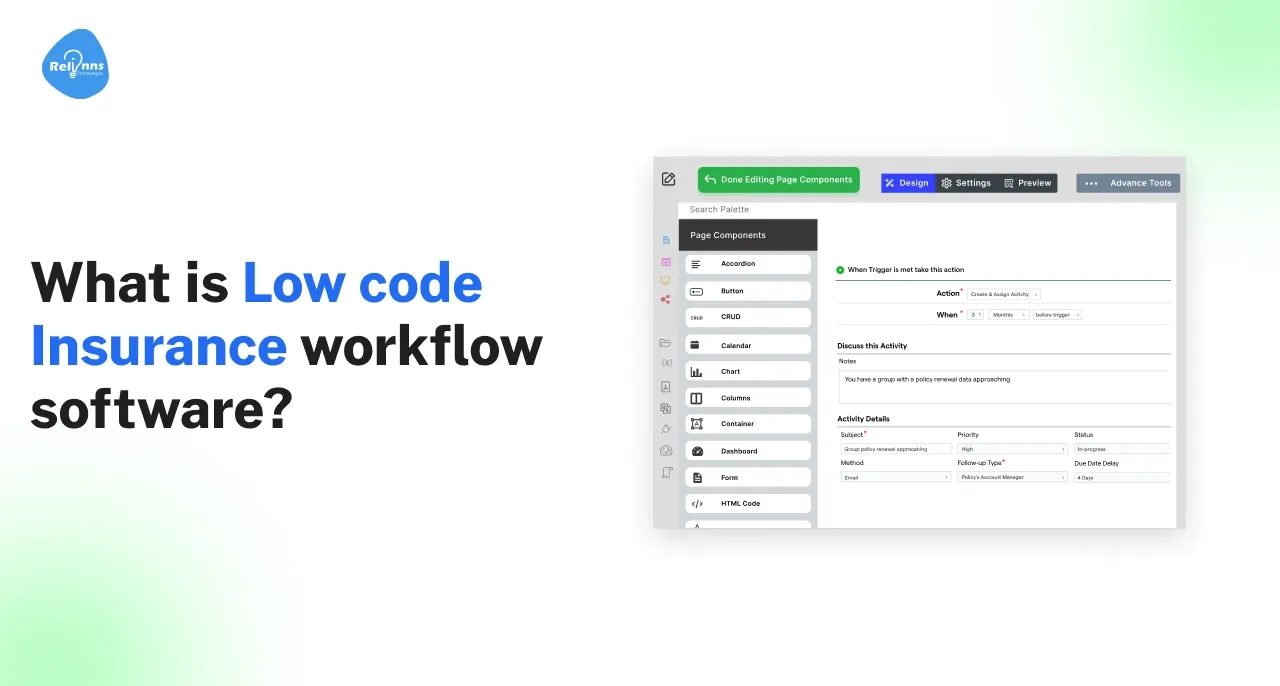
Introduction
Insurance workflow software uses low-code tools to streamline policy and claims processes. Insurers have traditionally relied on manual workflows and legacy systems, resulting in delays and errors.
Low-code insurance platforms enable non-technical teams to manage tasks by dragging and dropping workflows visually. This drives faster claims processing, fewer errors, and better compliance.
G2 reports 84% of enterprises adopt low-code to reduce IT strain and accelerate development, and Gartner predicts 70% of new apps will use low-code by 2025.
EY finds that 87% of customers say their claims experience affects loyalty, yet only around 5% of insurers automate claims entirely.
Low-code insurance automation software helps fill this gap by enabling the rapid creation and adaptation of claims and policy workflows, allowing insurers to manage complexity without incurring heavy IT overhead.
In this guide, we’ll explore how modern insurance workflow software—built on low-code platforms—empowers insurers to automate claims, manage policies efficiently, and deliver faster, error-free service at scale.
Why Low Code Matters in Insurance Workflow Management
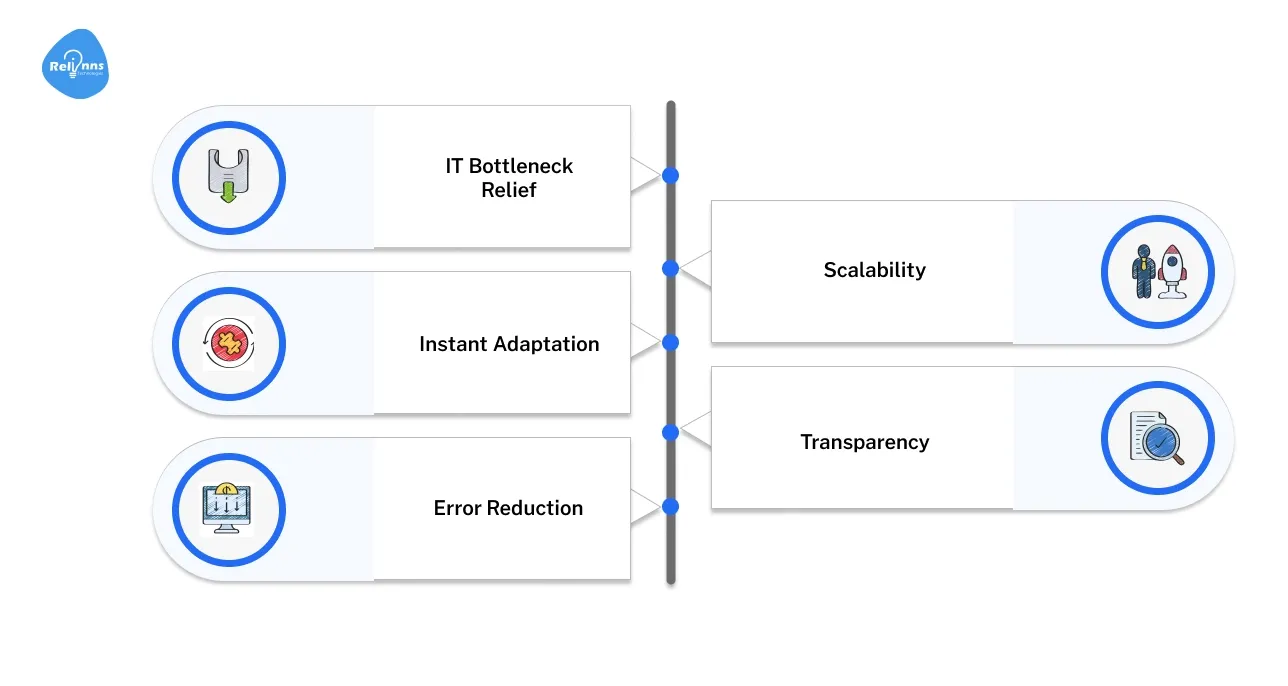
Insurance firms face heavy workloads and limited IT resources. Manually processing claims, underwriting, and compliance updates often creates backlogs and errors.
Low-code insurance platforms alleviate these pressures by enabling business users to design and tweak workflows directly.
For example, app development is 90% faster with low-code platforms. (Source: Hostinger) One insurer digitized hundreds of workflows (claims, billing, service) with low-code, showing even non-IT staff can build complex apps quickly.
- IT Bottleneck Relief: Non-technical staff can build and update workflows without coding, easing IT backlogs.
- Instant Adaptation: Business users manage policy rules and claims workflows via visual tools, adapting instantly to regulation changes.
- Error Reduction: Insurance automation software applies validation rules to catch errors early, reducing rework and denials.
- Scalability: Even small teams can handle high volumes with visual workflow tools, making it easy to add new processes.
- Transparency: A modern insurance claim management system built on low-code improves communication, ensuring that policyholders and agents always know the claim status.
These advantages let insurers cut costs and reallocate resources to innovation.
In short, a low-code insurance platform is a strategic asset that streamlines operations, ensures faster compliance, and enables insurers to focus on growth.
Must-Have Features in Low-Code Insurance Platforms
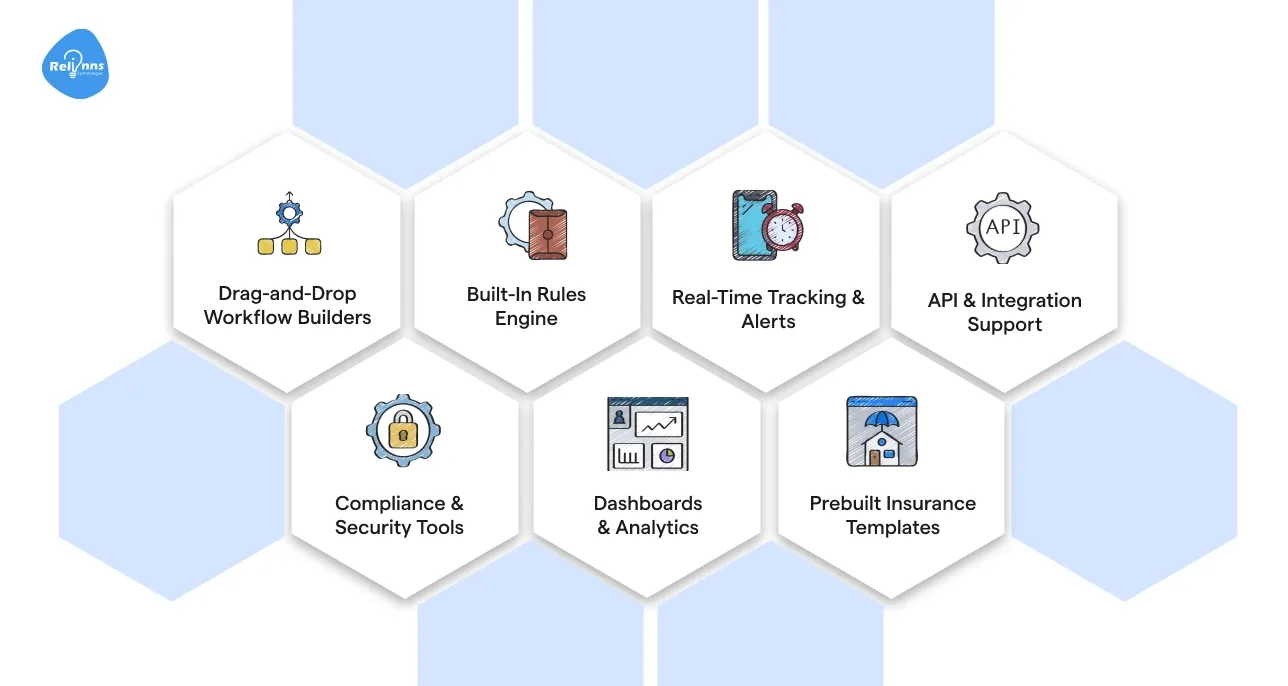
Not all tools are created equal. When evaluating insurance workflow software, prioritize features that enable fast, flexible, and secure automation of insurance processes.
Top low-code insurance platforms should offer the following.
- Drag-and-Drop Workflow Builders: Enable users to design forms and processes visually, allowing teams to create or modify workflows without coding quickly.
- Built-In Rules Engine: Automate insurance logic (eligibility checks, validations, approvals) so claims and policy tasks auto-verify against set criteria.
- Real-Time Tracking & Alerts: Provide instant status updates for claims and policies. Alerts notify teams immediately of issues to prevent delays.
- API & Integration Support: Seamlessly connect with policy administration systems, core databases, CRM, and third-party services.
- Compliance & Security Tools: Include audit trails, role-based access, and encryption to meet regulations. (Many platforms offer built-in data protection and audit logging.)
- Dashboards & Analytics: Provide reporting on key metrics, including claim volume, processing times, and error rates, enabling teams to improve their processes continually.
- Prebuilt Insurance Templates: Provide ready-made modules for common workflows (claims intake, policy issuance, renewals) to speed deployment.
These features give insurers visibility, control, and flexibility to manage claims and policy processes efficiently.
Top 7 Low-Code Insurance Workflow Software Solutions
Choosing the right low-code insurance workflow software depends on your organization’s size, complexity, and integration needs.
Below are seven top-rated platforms that help insurers streamline claims, manage policies, and ensure compliance, each with distinct strengths in automation, scalability, and customization.
1. Joget DX
Joget DX is a GenAI-powered, open-source, low-code platform that insurers use for custom process applications.
It features a web-based visual builder for forms and workflows, enabling the quick automation of claims processing, policy renewals, and other insurance tasks.
As insurance workflow software, Joget can help agencies manage approvals, client onboarding, and reporting with minimal code.
Key Features
- Visual app builder for custom workflows
- An extensive plugin library and marketplace for integrations
- Platform-flexible (cloud or on-premises) to match IT needs
- Role-based permissions and audit logs for compliance
- No licensing fees for the core platform (open-source)
- Rapid deployment (apps built and deployed in days or weeks)
Best Suited For: Small to mid-size insurers, MGAs, and agencies needing an affordable, highly customizable workflow solution.
2. Appian Insurance Cloud
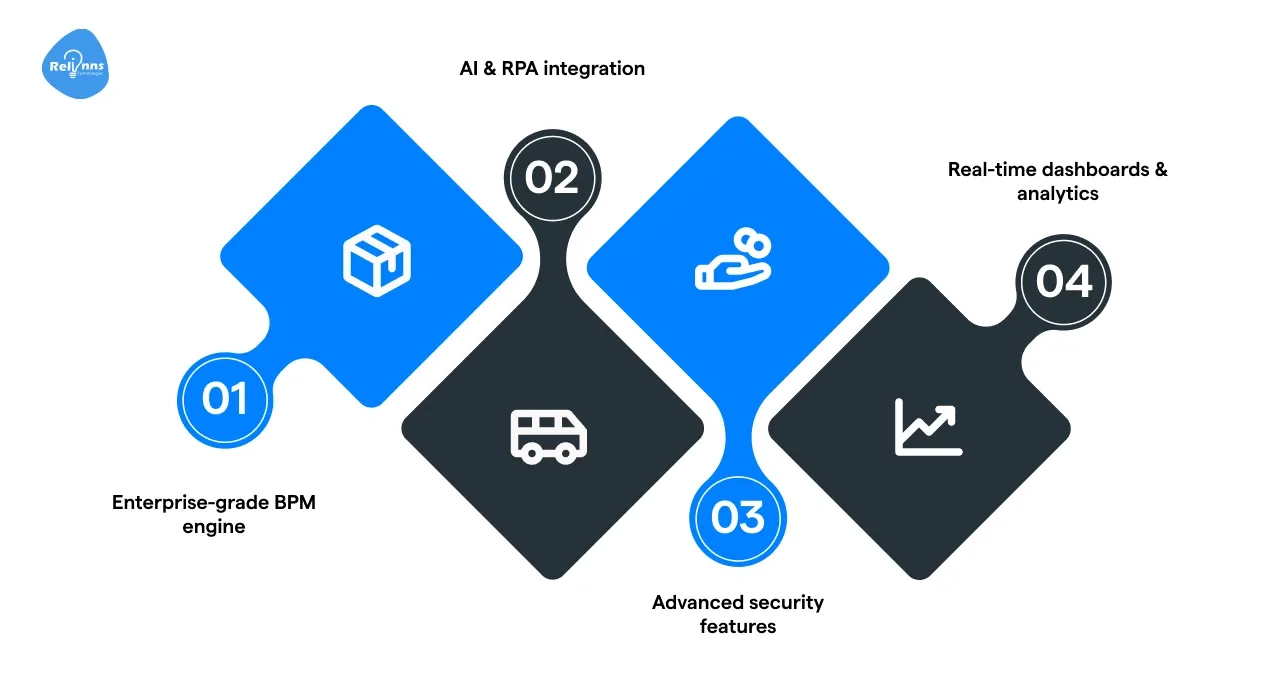
Appian Insurance Cloud is an enterprise-grade low-code insurance platform designed for large carriers and brokers. It lets insurers model and automate complex workflows (claims adjudication, underwriting, policy administration) without extensive coding.
Appian’s insurance automation software offers a drag-and-drop interface, robust case management, and prebuilt integrations with core policy and claims systems.
It helps insurers manage an end-to-end insurance claim management system efficiently.
Key Features
- Enterprise BPM engine for high-volume insurance processes
- AI and RPA tools to speed up claim validation and data entry
- Advanced security (role-based access, audit trails, encryption)
- Real-time dashboards and analytics.
Best Suited For: Large insurers, reinsurers, and brokers managing mission-critical, high-complexity workflows.
3. OutSystems Insurance Suite
OutSystems Insurance Suite is a versatile, low-code platform that is popular with insurers of all sizes. It enables rapid development of custom insurance workflows without deep coding.
The platform provides drag-and-drop design, reusable components, and AI-assisted development to simplify tasks like policy management, claims intake, and customer portals.
OutSystems insurance workflow software is cloud-native, making it easy to scale and deploy updates globally.
Key Features
- Intuitive visual builder with insurance templates
- Robust integration (APIs, connectors) to legacy systems and services
- Cloud-native architecture with offline mobile support for agents
- Automated testing and one-click deployment for fast time-to-market
- Built-in AI assistance for more brilliant app creation.
Best Suited For: Fast-growing insurers and agencies that need to launch new applications quickly (e.g., customer portals, quoting engines, claims tracking) while maintaining scalability.
4. Mendix Insurance Platform
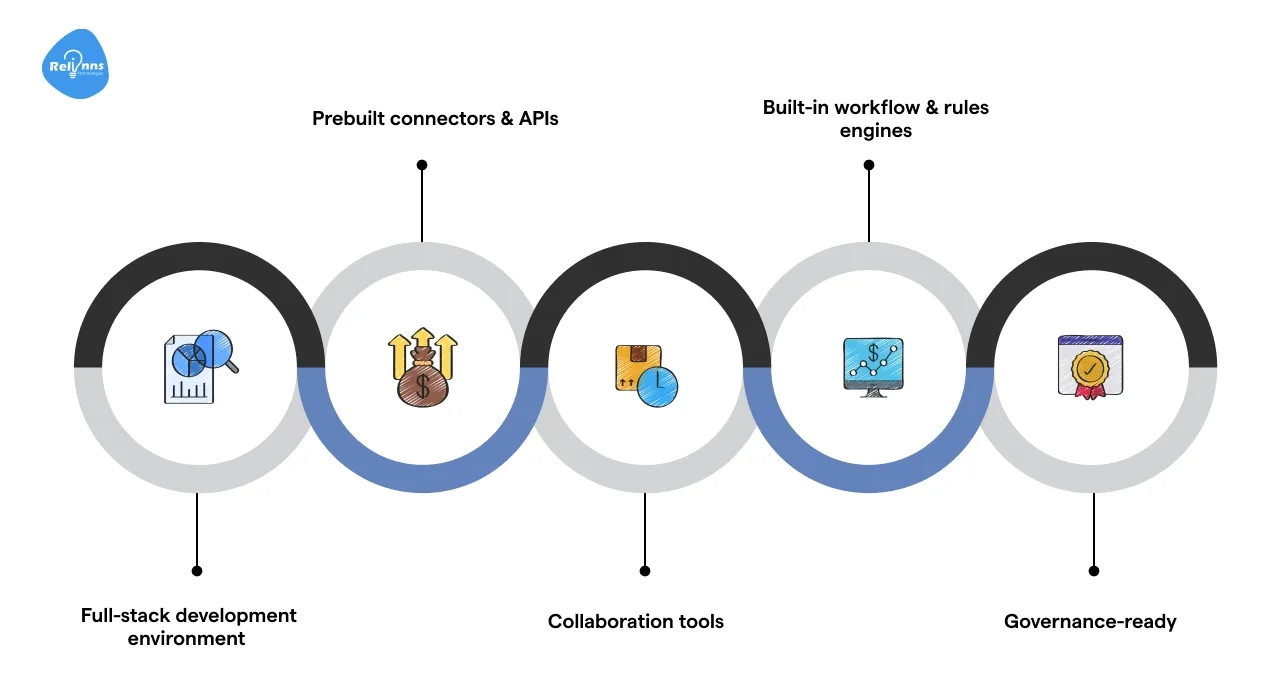
The Mendix Insurance Platform is a flexible, low-code enterprise platform used by insurers to modernize their workflows.
It supports both visual development and custom coding, letting teams manage simple forms and complex logic together.
Mendix’s insurance workflow software integrates with existing policy administration and claims systems to form a unified solution.
Key Features
- Full-stack development environment for maximum customization
- Prebuilt connectors and APIs to core systems (policy admin, billing, claims)
- Collaboration tools (version control, multi-user editing) for fast iterations
- Built-in workflow and rules engines to automate underwriting and claims processing
- Governance features (audit logs, testing tools) for compliance
Best Suited For: Mid- to large insurers with IT teams who require deep customization and legacy integration while benefiting from low-code speed.
5. Pegasystems Platform
Pegasystems Platform (Pega) is a leading low-code automation platform frequently used in the insurance industry.
Pega combines workflow automation with case management and predictive decision-making, enabling insurers to manage complex, case-driven processes without requiring extensive coding.
It’s often used to automate claims lifecycles, policy servicing, and customer interactions from end to end.
Key Features
- Dynamic case management engine for claims and policies requiring human judgment
- Predictive analytics and decision rules to automate fraud detection and risk scoring
- Built-in CRM and Omnichannel UI for streamlined communications
- Integrations with RPA and AI to automate repetitive tasks
- Enterprise-ready deployment with robust audit logging.
Best Suited For: Large insurers, reinsurers, and MGAs focusing on customer-centric operations and complex, adaptive workflows.
6. Salesforce Financial Services Cloud (Insurance)
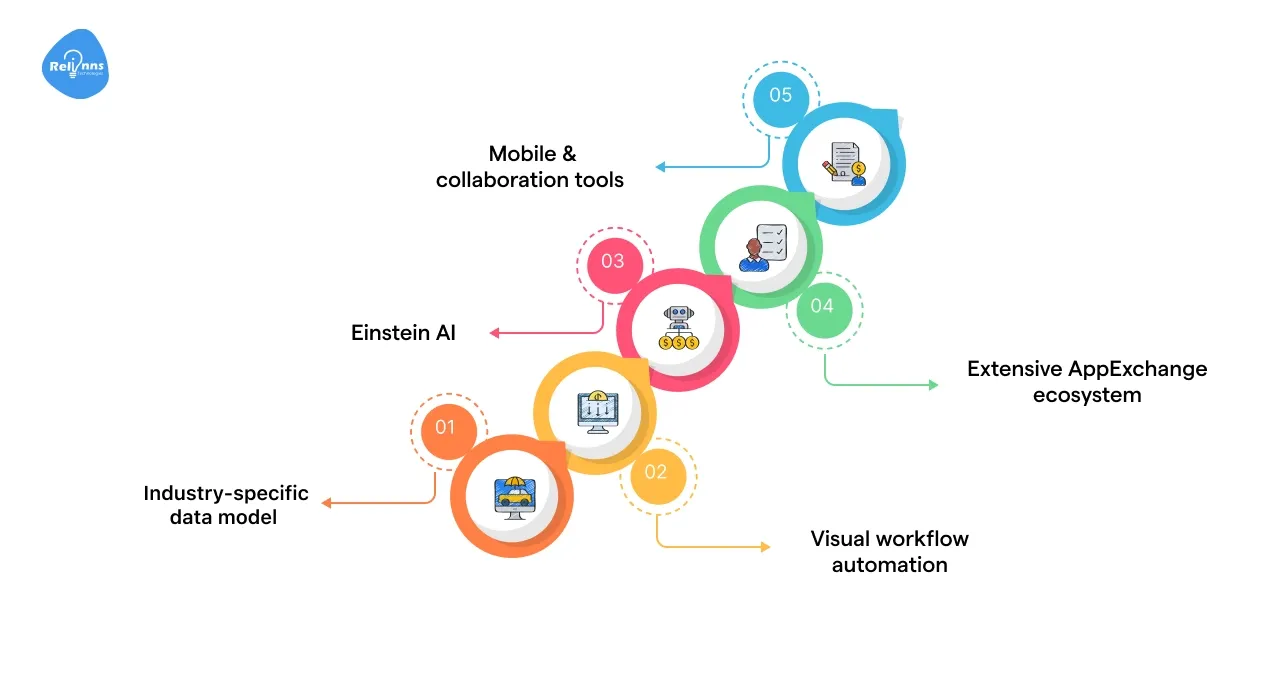
Salesforce Financial Services Cloud is an insurance workflow solution built on the Lightning low-code platform.
It unifies customer, policy, and agent data in one CRM, giving a 360° view of each policyholder.
Insurers use their declarative tools (Lightning Flow, Process Builder) to automate claim routing, policy renewals, and customer communications without coding.
Key Features
- Industry data model for insurance (policies, claims, agents, relationships)
- Visual workflow automation (Lightning Flow) for approvals and escalations
- Einstein AI for predictive insights (e.g., claim risk, cross-sell recommendations)
- large AppExchange ecosystem for integrations (policy admin, telematics, portals)
- Mobile and collaboration tools (Slack integration).
Best Suited For: Insurers, brokers, and MGAs already invested in Salesforce, looking to streamline processes, improve agent productivity, and enhance customer engagement.
7. Zoho Creator – Insurance Templates
Zoho Creator is an entry-level low-code platform that insurers and agents use to automate simple workflows.
It offers insurance-focused templates (such as claims forms, policy applications, and agent portals) so teams can launch apps quickly.
Zoho Creator’s insurance automation software is cloud-hosted and mobile-friendly, making it easy to get started with minimal IT.
Key Features
- Drag-and-drop app builder for insurance forms and processes
- Prebuilt insurance templates to reduce setup time
- Integrated reporting and dashboards to track claims, billing, and tasks
- Seamless integration and external services for end-to-end data flow
- Role-based access controls and encryption for security
- Fully managed cloud hosting by Zoho (regular updates, backups).
Best Suited For: Small insurance agencies, brokers, and niche carriers that need a cost-effective solution to manage workflows like claims processing and policy administration.
Comparison Table of Insurance Automation Tools
Insurance workflow software tools vary in features and focus. The table below compares some leading platforms by their ideal use cases and strengths.
Platform | Best For | Key Strengths |
| Joget DX | Small insurers and MGAs | Open-source, highly customizable |
| Appian Insurance Cloud | Large insurers, carriers | Enterprise-grade BPM, AI, and compliance |
| OutSystems Insurance Suite | Fast-growing insurers/agencies | Rapid development, cloud scalability |
| Mendix Insurance Platform | Mid-to-large insurers with IT teams | Flexible integration, full-stack dev |
| Pegasystems Platform | Large insurers, MGAs | Dynamic case management, AI decision-making |
| Salesforce Insurance Cloud | Insurers using Salesforce CRM | Seamless CRM integration, mobile apps |
| Zoho Creator | Small agencies and brokers | Cost-effective, prebuilt templates |
Use Case in Insurance Workflow Software Firms
A mid-sized InsurTech firm aiming to modernize its policy and claims management using low-code no-code app development.
Challenge: The client struggled with fragmented manual workflows across policy creation, underwriting, and renewals. Repetitive data entry, SLA delays, and scaling issues limited customer experience and operational efficiency.
Solution: Relinns Technologies developed a customized insurance workflow software solution utilizing Joget DX.
- Created dynamic policy and claims workflows with drag-and-drop builders.
- Configured multi-tier approval logic for underwriting decisions.
- Automated claim status updates via email/SMS alerts.
- Enabled reusable templates to reduce setup time and manual errors.
- Integrated PDF generation and compliance dashboards
Results
- Reduced policy workflow errors by 40% through reusable template logic.
- Claims processing speed increased 10× with end-to-end automation.
- Achieved 90% SLA compliance in renewals and issue resolution.
- Support tickets dropped 70% due to real-time customer updates.
- Boosted throughput 3× without increasing staff or infrastructure costs.
How to Choose the Right Low-Code Insurance Workflow Software
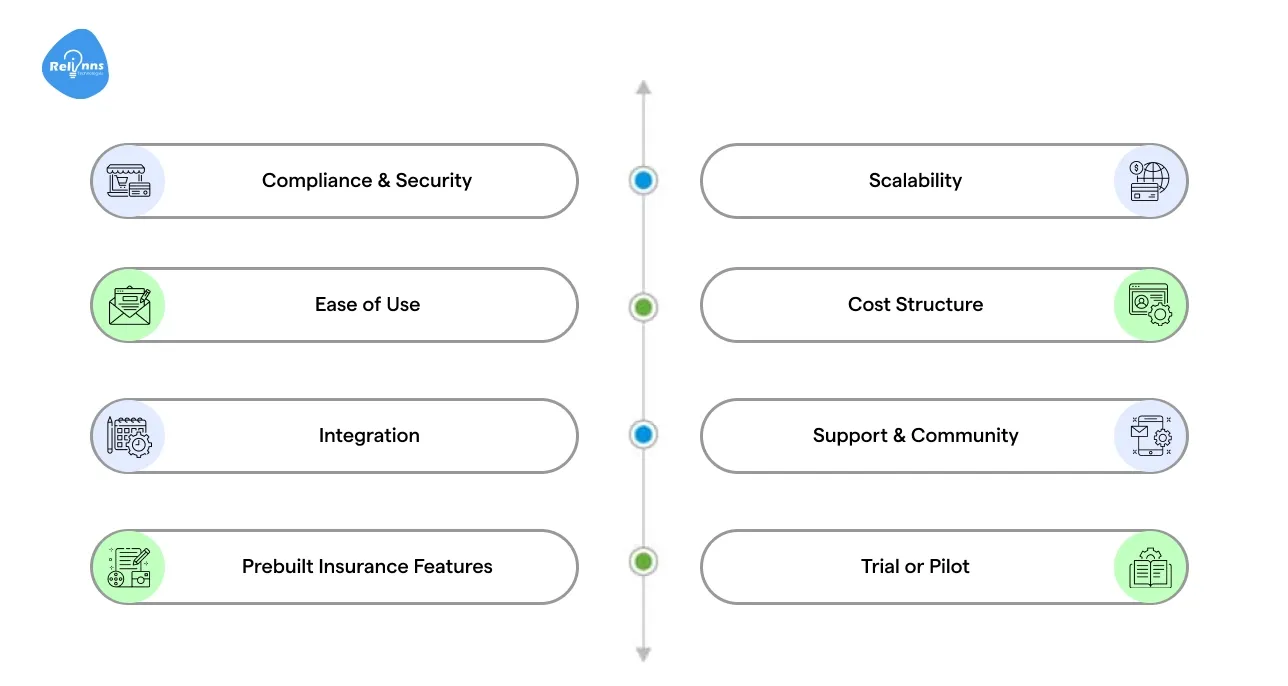
When evaluating insurance workflow software, consider factors like compliance, usability, and integration. The right platform should fit your scale and requirements. Keep the following tips in mind.
- Compliance & Security: Ensure the platform meets insurance regulations (audit trails, encryption, access controls) to manage risk and compliance.
- Ease of Use: Look for an interface that is intuitive and easy to use. Non-technical business analysts should be able to build or adjust insurance workflows with minimal training.
- Integration: Verify strong API or connectors to your core systems (policy administration, claims, billing, CRM). This avoids data silos.
- Prebuilt Insurance Features: Platforms offering insurance-specific templates or modules (claims intake forms, policy rules) can speed deployment.
- Scalability: Select a solution that can handle growth in policy volume and user numbers without performance degradation.
- Cost Structure: Consider licensing costs and total cost of ownership. Low-code tools can reduce development costs, but be aware of subscription fees.
- Support & Community: Favor vendors with insurance industry expertise and strong user communities. Good support and training resources aid adoption.
- Trial or Pilot: Always test a platform with a pilot project to confirm it meets your team’s needs before rolling it out fully.
Final Thoughts: Why Insurance Workflow Software Needs a Low-Code Partner Like Relinns
Low-code insurance workflow software can transform operations by automating processes and boosting efficiency.
For insurers seeking a proven solution, Relinns offers a specialized low-code insurance platform. Relinns provides built-in templates for claims, underwriting, and renewals, along with compliance features like audit trails and access controls.
Its solution integrates with policy systems and CRMs to unify data.
In practice, Relinns has delivered impressive results
- Claims processing time dropped from 6 days to 24 hours.
- Visual workflow tools empower business users with no coding needed.
- Regulatory compliance is ensured with built-in audits and role-based controls.
- Scalable platform supports claims, policies, and services without IT bottlenecks.
Relinns doesn’t just write code, they solve business problems with scalable, low-code solutions.
Contact us to discuss your Joget project and turn your product roadmap into a launch-ready solution.
Frequently Asked Questions (FAQ’s)
Can insurance workflow software support hybrid deployment across cloud and on-premises?
Yes, many insurance workflow software tools offer hybrid deployment, allowing insurers to manage sensitive data on-premise while scaling operations in the cloud for flexibility and compliance with regional regulations.
How does a low-code insurance platform handle third-party integrations like reinsurers or TPAs?
Low-code insurance platforms support seamless API integrations with reinsurers, TPAs, and fraud detection tools, enabling end-to-end visibility across the insurance value chain without disrupting internal processes.
What kind of analytics does insurance automation software typically include?
Insurance automation software features KPI dashboards, claim cycle reports, risk scoring, and renewal forecasting, enabling managers to make data-driven decisions and enhance customer retention strategies.
How does an insurance claim management system prevent duplicate or fraudulent claims?
A modern insurance claim management system utilizes built-in validation rules, integrates with fraud databases, and employs real-time duplicate detection algorithms to flag high-risk submissions during intake automatically.
Can insurance workflow software be used for agent onboarding and credentialing?
Yes, insurers use insurance workflow software to automate agent onboarding, license verification, and training certification, reducing setup time and ensuring compliance with regional regulatory bodies.
How does insurance automation software help during natural disaster claims surges?
Insurance automation software scales quickly to handle claim spikes, automating triage, routing, and documentation, allowing insurers to process high volumes more efficiently during floods, earthquakes, or storm-related surges.


